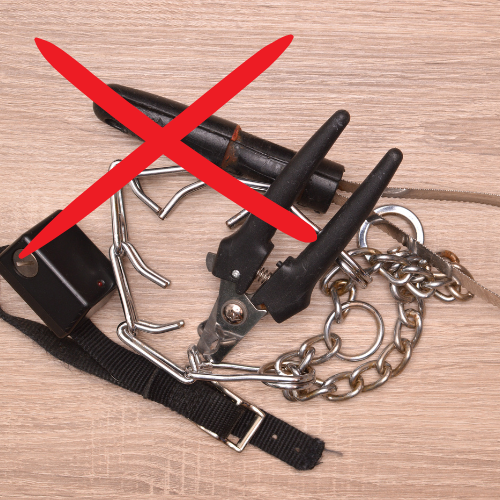Prong Collar Alternatives – Why You Shouldn’t Use a Prong Collar on Your Dog
Dogs are like our dearest buddies. You desire a puppy so that you may alleviate your feelings of boredom and loneliness by spending time playing with it in your free time. And once you have one, it becomes nothing less than a part of your family. As a pet owner, you know how much we love our pets. It is a terrible feeling when your pup is harmed or becomes injured.
If you use equipment such as prong collars for your dog for behavioral control, you must be informed that these accessories inflict pain on your pup daily. Unfortunately, it is your responsibility to be aware of this fact.
Here come prong-collar alternatives. The structure of these collars is slightly different from that of prong collars, but they are an excellent choice for the purpose.

In this article, you’ll learn about dog collars comparable to prong collars; these collars may be used as alternatives to prong collars.
Are Prong Collars Banned In The UK?
What Are Prong Collars?
Prong collars are chain-link metal collars with rough, angled protrusions that penetrate the dog’s skin. The prong collar is positioned just below the pup’s jaw and is not intended to pinch until the pet parent or dog pushes on the leash. This collar is comparable to the choke collar and martingale collar but lacks the protrusions (or teeth) found in pinch collars.
Are Prong Collars Safe for Dogs?
There are contradictory opinions on the safety and effectiveness of prong collars. When worn appropriately, prong collars don’t hurt the trachea but can damage the neck skin, which is thinner than humans.

One further problem is that many people who own canines don’t know how to put on a prong collar the right way. Incorrect usage of a prong collar poses a significant risk of injury to your puppy’s neck’s sensitive skin and trachea. Prong collars may be seen as punishment by dogs, causing emotional and behavioral disorders.
Why Do I need Alternatives to Prong Collar?
Prong collars are composed of a chain with a pointed tip that causes pain and discomfort when walking. A choke chain is a lengthy chain made of metal rings often used as a behavioral modification.
However, utilizing it can also lead to other injuries, such as a sprained neck, damaged nerves, fainting, collapsed trachea, etc. A shock collar, sometimes known as an electronic collar (or just e-collar for short), is another well-known instrument for behavioral control. It shocks your dog with electricity to make him behave softly. It’s worse than it sounds.
You can use a head collar, head halter, no-pull harness, hand-free leashes, or muzzles instead of uncomfortable collars. They all assist you in teaching your pup efficiently and are highly successful in doing so. Not all of these items may be ideal for your new dog. You simply need to choose the option most suited to your needs from among all of these.
Alternatives to Prong Collars
Flat Collars
When you think of a dog collar, the first type that probably comes to mind is a flat collar. This collar is flat and made of leather, nylon, or cloth. A metal or plastic slide-release buckle can be used to close flat collars, depending on personal preference.
When worn excessively tightly, this collar can cause discomfort or sink in the dog’s neck, and it has the potential to induce choking in canines who pull. You should be able to easily slide two fingers in and out of the space between your pup’s neck and the flat collar.
A broad, studded flat collar helps protect the necks of aggressive, fighting, and pulling dogs. This helps distribute pulling force across a large region of your dog’s neck, preventing harm while fighting or tugging.
Front-Clip Harness
This collar is used to treat injured dogs. It minimizes the drag strain of the harness and is an ideal alternative to prong collars.
The front clip harness is suited for loose-leash training and is ideal for all kinds and sizes of dogs, including toy types, breeds with short noses, and pups with medical conditions that affect their airways.
Pressure on your dog’s neck can cause medical concerns, including compressed trachea, gasping anxiety, soft cartilage, cervical disc injury, ocular, carotid artery, and jugular vein pressure. A front-clip harness alleviates stress and decreases strain on your dog’s neck.
Head Halter
The head halter is yet another type of collar that is safe and kind to use on your dog. This collar has a strap that fits around your dog’s neck and behind his ears, but you must link a leash under his chin to the nose strap’s ring to operate.
If your dog pulls or tries to escape while the head halter is on, the head halter will cause your dog’s nose to tilt back towards you. Your pup will have a harder time escaping or pulling due to this development.
Martingales
Martingale collars are theoretically comparable to prong collars, with the exception that the primary material used in the construction of martingale collars is nylon webbing rather than metal links. Thus martingale collars do not have any prongs.
While martingales are generally considered the form of corrective collar that is safest to employ daily, there are still hazards associated with their usage in this situation.
Some dog owners prefer martingales over traditional collars because they prevent dogs from slipping out of their collars and running free, making them an excellent option for Houdini-style escape artists.
Slip Collars
Slip collars are like chain collars, but with rope instead of chain links. They provide the same function that chain collars do in the same way. A stopper is typically included with slip collars, and its purpose is to prevent the collar from opening farther than desired.
How Do You Choose the Best Alternative to Prong Collars for Your Dog?
Before you go out and buy an alternative to a prong collar, there are several requirements that you need to make sure you follow.
Perfect Size & Color
If you want a collar for your pup, you only need to measure its neck. However, you must measure the neck and chest to purchase a harness for your pup.
Construction Materials
You may choose to focus on the material as an alternative to a prong collar. Collars may be purchased in various materials, including nylon, leather, imitation leather, and bio thane.
Collars and harnesses made of nylon are currently the most often used among dog owners. It is available in various sizes, colors, patterns, and designs and has multiple properties. They offer the greatest level of comfort at a surprisingly affordable cost.
Design
The style and construction of dog collars vary. You need to pick the one most suitable for your canine companion from among them. A front and rear clip on the dog’s vest harness makes it more convenient.
Style
After considering all the criteria, you may want to ensure the item complements your pet’s style and personality. Because at the end of the day, you want him to appear cute in his new clothing, this is your priority.

Doctor of Veterinary Medicine (D.V.M.) at Nation Taiwan University,Master of Science (M.S.) in Biomedical Engineering at National Taiwan University of Science and Technology




